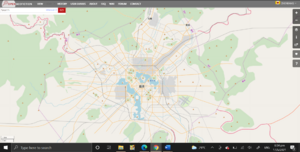Collab:Bai Empire/Xiongjing
Xiongjing is the capital of the Bai Empire. This page is mainly to coordinate collaboration for the city with a list of available projects.
Interest in participtation
As of now, I am still setting up the city and the project page. If you like to join in constructing this glorious city, message me or ask on the discussion page.
General layout
Xiongjing is constructed on a high altitude plateau with two large lakes. The city, master-planned since its inception in 1822, is based around the government quarter within an 8 by 8 km zone. The government quarter is where most of the government institutions are located, with the palace as the centrepiece. Around the government zone are several key commercial zones around major rail stations, such as Central Station, Prince Terminus and East Station.
Generally, the more hilly and mountainous areas of the north, south and east are where many middle-class and upper-class people reside. Around the rail lines are the industrial areas, with neighbourhoods of workers and low-income families. The flatter west and southwest are where there will be more master-planned neighbourhoods intended to cater to the growth of the city during the 60s to 80s.
The city layout is intended to be based on Chengdu, though other inspirations include Mexico City.
Transport
The city will have an extensive bus and metro network to cater for the large population. Check the public transport viewer for the full view of transportation in the city. As of June 2021, the metro system is still in progress. A tram system may exist to serve the government quarter, as tunnelling through the quarter may raise security concerns with the underground secret labyrinth running under the area.
The city has two airports. This is the main international airport, which has long taken over the Beiduan International Airport at the north. There might be additional smaller ones, though I intend to map up to three or four airports in total.
Bus
I am open to anyone establishing bus routes in the city. However, follow the conventions as shown:
| Convention |
|---|
|
| Project name | Description | Map area | Project Status |
|---|---|---|---|
| Bus | |||
Metro map
Loading map...
Government
While some might consider this section to be more suited for the country's page itself, I rather have it here than on that main page, since being the capital, it will have more relevance here.
As participants of the Empire should know, the Bai Empire is a semi-constitutional monarchy with the Emperor as the Head of State and the Chancellor as the Head of Government. Executive and legislative powers are shared by both the monarch and a bicameral parliament – the Imperial High Council (upper house) and the Imperia Senate (lower house). l In addition to the typical three branches of government (executive, legislative and judiciary), the Bai Empire has two additional branches (as envisioned by Sun Yat-sen for a democratic government for China). The Censorate, a carry-on from past imperial governments, "supervises and disciplines" politicians and civil servants, alongside auditing the national budget and resources. There is also the Examination branch that processes any prospective personnel who wishes to enter government service.
The executive, or the Imperial Palace, is at the centre of the capital. Surrounding the Palace are the major buildings of the four branches – the Imperial Congress (west), the Supreme, Constitutional and High Courts (south), the Censure Commission (east) and the Imperial Civil Service Institute (north and extending onto Zhengyi Island). Alongside these buildings are various governmental departments, which are listed accordingly:
| Institution | Baiyu name | Branch | Parent Ministry | Location (if built) | Functions |
|---|---|---|---|---|---|
| Ministries of the Bai Empire | |||||
| Grand Chancellor Office | 大统领公署 | Legislative | To be within the Grand Palace | ||
| Ministry of Defence | 国防部 | Legislative | |||
| Ministry of Internal Security | 国内安全部 | Legislative | |||
| Ministry of Foreign Affairs | 外交部 | Legislative | Map∈⊾ | ||
| Ministry of Economy and Finance | 经济及财政部 | Legislative/Censure | Manages the national budget and economic forecast | ||
| Ministry of Trade, Industry and Investments | 贸易、工业及投资部 | Legislative | Manages trade relations and businesses (including ownership dispute, merging of companies etc) | ||
| Ministry of Agriculture, Environment and Resources | 农业、环境和资源部 | Legislative/Censure | |||
| Ministry of Infrastructure Development | 基础设施发展部 | Legislative/Censure | Urban planning | ||
| Ministry of Transport | 交通部 | Legislative | |||
| Ministry of Health and Social Services | 卫生和社会服务部 | Legislative | |||
| Ministry of Education | 教育部 | Legislative | |||
| Ministry of Culture | 文化部 | Legislative | |||
| Ministry of Communications | 通讯部 | Legislative | |||
| Ministry of Law and Justice | 法律与司法部 | Legislative/Judiciary | |||
| Government agencies | |||||
Foreign Affairs
The Bai Empire is very keen to establish relations with all nations as long as they are willing to submit to our dominance and pay tribute to the divine Emperor. Embassies can be placed anywhere around the Government Core or any of the commercial areas, depending on your country's establishment. Older countries with longer historical ties will have theirs closer to the Core, while newer ones might have to squeeze in any available space around the capital.
